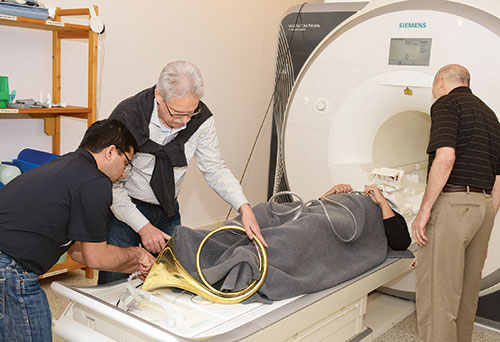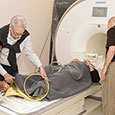Brass pedagogy is rich with strategies for playing posture, breathing mechanics, tone production, articulation, and embouchure formation. Most information for these techniques comes from observing external movements, and much of a teacher’s success relies on the ability to link these movements to artistic musical performance. Students observe the approaches of their teachers and of elite performers, and imitate them in a quest for similar prowess.

Performance mechanics involving the oral cavity have been shrouded in mystery. When students ask questions about tonguing, tongue position during sustained and changing notes, oral cavity configuration at different dynamics, movements of the larynx, and even control of the glottis, teachers face some difficult choices. At best, a savvy teacher develops guiding principles based on what others have said or their own perception of what they believe allows them to succeed. However, teachers believe different things about what they do, particularly regarding the inner workings of the mouth and throat. Exciting new technology developed in Germany is providing much-needed answers through clear, objective evidence that shows what really happens.
For the past three years, I have been the principal investigator in a series of studies using real-time magnetic resonance imaging (RT-MRI) technology to study movement patterns occurring inside the mouths and throats of brass players. In a collaborative effort involving the Max Planck Institute for Biophysical Chemistry (Göttingen, Germany), the Institute for Music Physiology and Musician’s Medicine (Hannover, Germany), and Gordon College (Wenham, Massachusetts), we have systematically studied healthy elite brass performers (e.g. horn players from the Berlin Philharmonic) as well as performers affected by embouchure dystonia, a movement disorder that causes the player to lose control of the muscles controlling the lips, and is most often career ending. RT-MRI technology enables us to capture videos at rates as high as 100 frames per second, thus allowing visualization of even the fastest movements that occur during such activities as double tonguing and lip trills. So what have these films revealed, and more importantly, how can this information be useful to music educators? I will discuss two findings involving the tongue, and one involving the glottis.
Tongue
Our MRI films answer some important questions concerning the role of the tongue. We wanted to know if the tongue is involved in shaping the oral cavity differently when playing in the low, middle, and high registers. Although our initial findings pertain primarily to horn players, it appears that the tongue assumes a low, pulled-back position during lower notes and progressively moves forward and upward in the mouth as higher pitches are played. (See Figure 1)
This is not a new idea by any means, but the predominance of this movement pattern seen in the films of elite horn players provides concrete evidence of a recurring pattern. Our preliminary, unpublished results suggest a similar pattern with trombone players, but trumpeters seem to keep the tongue up and forward throughout the range of the instrument. In many players affected by dystonia, this level of tongue control may actually be lacking. This appears on the MRI films as a more static, low, and forward thrusting tongue throughout the range of the instrument. (See Figure 2)
Another question concerns movements of the tongue in producing different dynamic levels. It has long been posited that the tongue rises within the oral cavity as a point of resistance to reduce airflow in soft playing, and our data confirms this. However, we found that an actual channel forms between the top surface of the tongue and the roof of the mouth, with the sides of the tongue rising to seal the edges of this channel on the upper molars. The size of this channel changes depending upon how softly (small channel) and how loudly (larger channel) a performer plays. (See Figure 3) Although results are preliminary, this appears to be true in horn, trumpet, and trombone players. We have seen one dystonia patient who could not form this channel because of a lack of tongue control.
.jpg)
Figure 1. Side view of tongue position during sustained notes in elite player (left to right: Eb2, Eb4, Bb4, and Eb5 concert).
.jpg)
Figure 2. Side view of tongue position during sustained notes in dystonic player (left to right: Eb2, Eb4, and Bb4 concert; Eb5 was not possible for this player).
.jpg)
Figure 3. Front view looking through the cavity formed by the tongue surface and the roof of the mouth (Bb5 at pianissimo, left and at fortissimo, right). The cavity is the large central dark area.
Glottis
A third finding from our MRI films concerns movements of the glottis during brass playing. Brass teachers have long advocated keeping the throat open during performance. We wanted to find out if this was an accurate suggestion. For air to move from the windpipe (trachea) into the oral cavity, it must move through the passageway between the opposing vocal folds. This opening, which sits at the upper extent of the larynx, constitutes the glottis. Presumably, keeping the throat open involves keeping the opposing vocal folds pulled apart, preventing them from contacting each other and creating vibrations that we associate with vocalizing. We wondered if this actually happens. Renowned horn player and teacher Philip Farkas created quite a stir when he advocated using the glottis as a controllable point of resistance for soft dynamic playing. He suggested that the glottis acts as a whisper valve to help regulate the volume of air moving through it, perhaps providing assistance at soft dynamics.
We have developed a way to visualize the movements related to the glottis during playing, and have many MRI films showing its position during playing. From those films, we recently published some interesting findings that support Farkas’s original idea. Indeed, it appears that in the elite horn players we have studied as well as in a trumpet player, the folds come closer together for soft notes and move farther apart for loud notes. The glottis appears to be involved in staccato note playing as well, closing completely at the termination of each note during slow tempos.
The idea of using vowels to assist in note production during brass playing is not new, but in terms of the role of the tongue in producing different pitches across the range of an instrument, our films confirm the legitimacy of this approach. We have numerous MRI films of horn players speaking the syllables haw, huh, heh, and hee and then playing notes in the low, middle, middle-high, and high registers. In many of our elite subjects, the tongue positions for these notes are remarkably similar to the positions that occur in speaking these syllables. Eli Epstein, horn faculty member of New England Conservatory and Boston Conservatory at Berklee in Boston, advocates using vowels to conceptualize efficient tongue positions during melodic playing to assist the young player who is having trouble instinctively producing the correct notes. This seems to be particularly helpful for playing the higher notes using a hee vowel position.
Instructing students to employ the glottis for soft or staccato notes is probably more controversial. Some teachers may fear that an effort to regulate the opening between the vocal folds involves excessive tightening of the neck muscles. However, this is avoided with proper instruction, and showing students how the glottis actually moves may provide helpful insight for those struggling with soft and staccato playing. Certainly Philip Farkas advocated teaching glottal control, and his book provides helpful ideas for how to do this effectively.
Conclusion
When considering how to use these RT-MRI films, I would like to mention two colleagues with stellar careers as both artists and teachers, Eli Epstein (Cleveland Orchestra, horn) and Douglass Yeo (Boston Symphony, trombone). Both have been in the MRI scanner in Germany, and have shown keen interest in this work, advocating strongly for continued research to provide objective, scientific evidence for best practices in pedagogy. Epstein has already used images from our work in his third edition of Horn Playing from the Inside Out: A Method for All Brass Musicians, and Yeo is working on a book on trombone that will feature a chapter on the MRI work and its implications.
Our RT-MRI work was recently featured on the Deutsche Welle television program Sarah’s Music (episode title, “Music and Science,” 9/4/2016, http://www.dw.com/en/sarahs-
There is much more that we will be working on in the near future. In collaboration with Dr. Jens Frahm of the Max Planck Institute for Biophysical Chemistry, a new project has been launched called the MRI Brass Repository Project (MBRP). The goal of this project is to continue applying RT-MRI technology to the search for ways to cope with the career-ending movement disorder embouchure dystonia and to acquire, organize, and make additional RT-MRI films available featuring elite brass players. We intend to organize this repository so music educators can easily identify and use individual films of top players performing musical exercises designed to illustrate varying aspects of brass technique. We anticipate making these films available by the fall of 2019. Updates for the project may be followed at www.gordon.edu/mrihorn.
Finally, a word of caution is in order. No two brass players do everything the same way. Although our films have shown patterns of movement consistency between elite players during specific exercises, every performer has unique anatomical features that will necessitate careful interpretation by the teacher in the specific way these films may be applied. Further, there is a strong argument for not becoming overly analytical about the mechanics of brass performance. Too much attention to the tongue or throat could easily detract from making beautiful music. It would be foolish to suggest one size fits all with regard to our data. However, an equally strong argument is that these examples of top players represent a gold standard of performance. The sounds these artists make are sonorous, powerful, and accurate, and these players do it all with great efficiency. Moreover, their approaches apparently lead to sustainable, healthy careers. If we can learn general principles from these MRI films that can help developing students to play more efficiently, then their use seems warranted.
Bibliography
Inefficiencies in Motor Strategies of Horn Players with Embouchure Dystonia by Peter W. Iltis, et al, from Medical Problems of Performing Artists, 2016. 31(2): p. 69-77.
Divergent Oral Cavity Motor Strategies Between Healthy Elite and Dystonic Horn Players by Peter W. Iltis, et al, from Journal of Clinical Movement Disorders, 2015. 2: p. 15.
Real-Time MRI Comparisons of Brass Players: A Methodological Pilot Study by P. W. Iltis, et al, from Human Movement Science, 2015. 42: p. 132-45.
The Art of Brass Playing: A Treatise on the Formation and Use of the Brass Player’s Embouchure by Philip Farkas. (1962, Bloomington, Ind.: Brass Publications. 65 pages.)
Movements of the Glottis During Horn Performance: A Pilot Study by Peter W. Iltis, et al, from Medical Problems of Performing Artists, 2017. 32(1): p. 33-39.
Horn Playing from the Inside Out: A Method for All Brass Musicians by Eli Epstein. (2016: Eli Epstein Productions. ix, 156 pages.)






